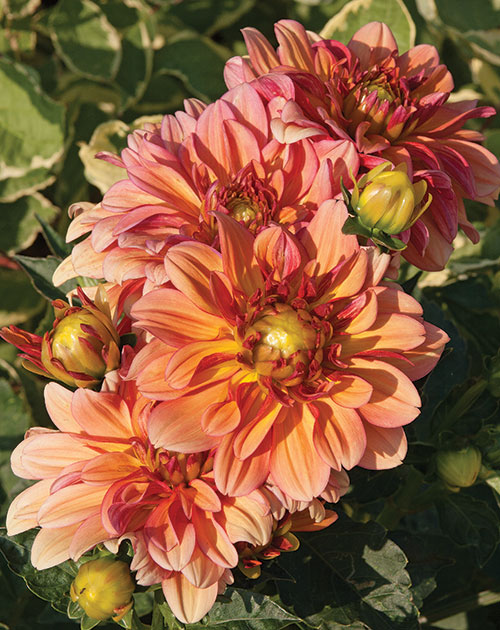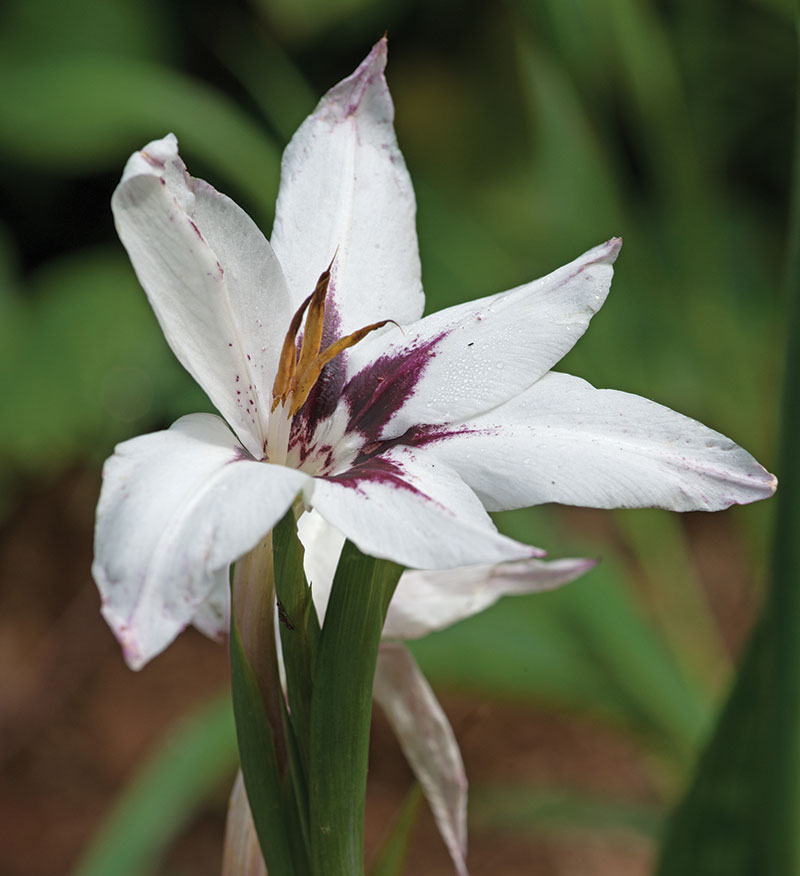If I were grading flowering plants for their possible inclusion in an ornamental garden, I would consider such common desirable traits as ease to grow, good looks and pleasant scent. But before giving out any report cards, I would also factor in one more attribute: undeserved infrequent use.
With such a skewed system, I certainly give acidanthera an “A.”
Sure, acidanthera sounds like a 1960s Haight-Ashbury rock opera, and to further muddy the waters, it has many alternate appellations — peacock orchid, Abyssinian gladiolus, sword lily and African gladiolus. Ditto for its botanical listing — variously classified as Acidanthera bicolor, Acidanthera murielae, Gladiolus murielae and Gladiolus callianthus. But from all these names, there are clues to the nature of this cutie.
Acidanthera is a gladiolus kin originally from mountainous eastern Africa. Like a glad, it sends up slender blades of greenery before long flower stalks come out to play. And being from high country, it prefers well-draining growing ground.
But this is where it gets a little weird: Acidanthera was introduced to Southern gardens in the late 1800s, and adapted well to our climate and soil conditions to the point of being an easy to grow and propagate heirloom plant. Now, do you know anyone who has it in their garden? Maybe its name(s) has made casual gardeners hesitant, but smart growers well appreciate acidanthera for dependability and beauty.
Acidanthera is grown from small corms, which are best planted this month. They should be sited in an area with well-worked, loamy soil that receives full morning and early afternoon sun. Set the corms about 5 inches deep, and space them 4 inches apart.
Sword-like foliage will soon rise to a height of 2 to 3 feet — and then the fun begins. In August, when many plants in the summer garden sulk, acidanthera (it’s deer-resistant, by the way) sends out long spikes topped with nodding clusters of white, orchid-like blooms streaked in burgundy with a captivating perfume that grows stronger as the sun starts to set. Planting in masses will only intensify this pleasant olfactory experience.
Since acidanthera likes good drainage, it is perfect for pots. In fact, although the acidantheras in my garden have weathered winters well for years, I have still filled a few containers with their corms to enjoy on my deck. As the late autumn cold closes in, I simply snip off the faded foliage and tuck the pots away in a warm, dry area until the next spring.
Still remain on the fence about inviting this exotic dancer to your summer garden party? I’ll add it is also a cheap date. This time of year, I can easily find acidantheras in local big-box garden centers as well as online, and they normally cost about five to six bucks for a dozen corms.

Dahlia
Late April is a prime planting time for dahlias. Their tuberous roots should be set in a morning to midday sunny spot that has mounded, well-worked soil. Since many dahlias can get tall and floppy, place a stake next to each tuber when planting to avoid disturbing roots later.
Don’t water newly planted tubers. After sprouts appear, begin watering at least twice weekly and applying small doses of low-nitrogen fertilizer monthly through the growing season. In late May, add a 3-inch layer of mulch to help conserve ground moisture. Pick off any spent blooms to encourage more summer flowers.
Dahlias are marginally hardy in our area, so in the late fall, either dig the tubers up and store them (recommended), or take a chance on a mild, dry winter and leave them in the garden under 3 to 4 inches of fresh mulch.
To Do in the Garden
April
- Flowering annuals will benefit from an application of slow-release fertilizer at planting time, but to get them off to a quicker start, also water with a diluted liquid fertilizer for the first few weeks your pretties are in the garden.
- Speaking of fertilizer, do you want the best production of fancy foliage from caladiums? Remember that caladiums, while pretty, are pigs. They need generous amounts of water and fertilizer on a regular basis in order to continue producing swanky new leaves through the growing season.
- Scented geraniums are at their best when they are in the way. In other words, place them at the front of a border, on the corner of a path or close to a doorway where passersby will brush up against them, releasing the plants’ sensational aromas.
- Are you a seedy gardener? If so, the middle to end of this month is the time to start the warm-season vegetable patch by direct sowing the seeds of cucumbers, squash, corn, green beans, pumpkins, watermelons and cantaloupes.
- Tomato transplants can also be added to the spring veggie garden after the third week of April. Sneaky tip: For a quicker, stronger start, take advantage of the warm soil close to the surface (which induces root growth) by setting the plants parallel to the ground in trenches rather than deep holes. Bury all but the upper 3 to 4 inches of each plant.
- Putting up new bird houses this year? Although metal houses can look cute, stick with wooden ones instead — they are better at insulating nesting birdies from the worst of the summer sun.







